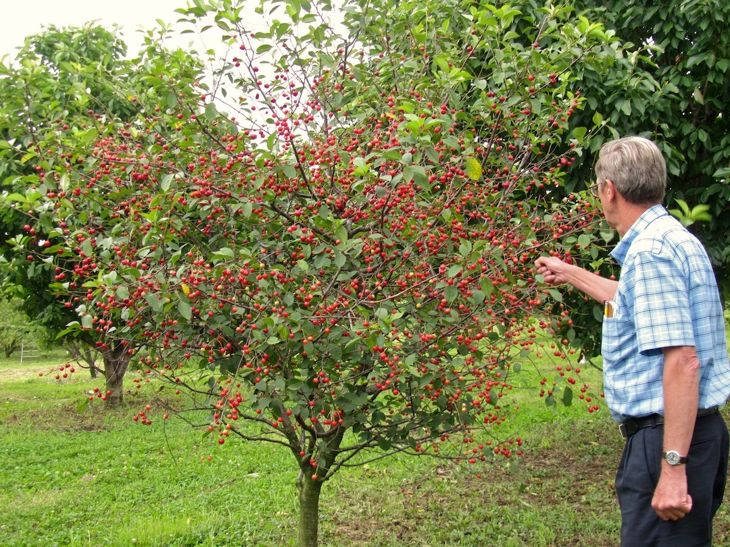Elevate your garden with dwarf cherry trees that thrive in small spaces and bear delicious fruit!
Cherry trees are a popular choice for home gardens and landscapes. Their spring blossoms and summer fruits add beauty and harvest. While full-size cherry trees can grow over 30 feet tall dwarf cherry tree varieties reach a more manageable size. If you’re wondering, “How tall do dwarf cherry trees grow?” here’s what you need to know.
What is a Dwarf Cherry Tree?
Cherry trees are classified by their growth habits and final heights
-
Standard cherry trees grow over 20 feet tall.
-
Semi-dwarf cherry trees reach 15-20 feet tall.
-
Dwarf cherry trees grow 8-10 feet tall.
Dwarf cherry trees are grafted. This means the top portion is joined to a rootstock that restricts growth. The result is a small tree that matures faster and is easier to maintain. Their compact size makes dwarf cherries ideal for small yards.
Typical Mature Height of Dwarf Cherry Trees
Dwarf cherry trees average 6-8 feet tall at maturity, but some varieties may reach 10 feet. Here are the mature heights of popular dwarf cherry cultivars:
-
North Star: 8-10 feet
-
Romeo: 6-8 feet
-
Crimson Passion: 6-8 feet
-
Rainier: 8-10 feet
-
Royal Lee: 6-8 feet
-
Sweetheart: 8-10 feet
As you can see, most dwarf cherries grow in the 6 to 10 foot range when fully grown. Pay attention to a variety’s expected mature height when selecting trees.
Factors Affecting Dwarf Cherry Tree Height
The final size of a dwarf cherry depends on a few factors:
Rootstock: Different rootstocks limit growth to varying degrees. Mazzard roots produce the largest dwarf trees. Gisela rootstocks result in the most compact cherries.
Cultivar: Some dwarf cherry cultivars grow slightly larger. For example, North Star and Sweetheart may reach 10 feet.
Climate and care: Ideal conditions and attentive care allow dwarf cherries to reach their maximum potential height. Insufficient water, nutrients, or sunlight may stunt growth.
Pruning and training: Pruning and training techniques like espalier can restrict dwarf cherry tree size. Conversely, neglected pruning allows trees to grow larger.
Age: Dwarf cherry trees may take over 5 years to achieve their mature height. Give young trees time to reach their potential.
Tips for Controlling Dwarf Cherry Tree Height
If your dwarf cherry is growing too large, you can take steps to contain its size:
-
Choose dwarfing rootstocks like Gisela 5 or Gisela 12.
-
Opt for more compact cultivars like Romeo or Royal Lee.
-
Prune diligently each year to remove vigorous vertical shoots.
-
Train your tree as an espalier on a trellis or wall.
-
Limit nitrogen fertilization to avoid excessive vegetative growth.
The Takeaway
Dwarf cherry trees offer gorgeous blossoms and bountiful fruit harvests in a petite package. While individual cultivars vary, most dwarf cherries reach mature heights of 6-10 feet. Select the right rootstock, cultivar, and training method to achieve your ideal tree size. Proper planting and attentive care will help your dwarf cherries thrive without outgrowing their space.

Factors Influencing Growth Rate
The growth rate of dwarf cherry trees can be impressive, reaching up to 2 feet per year under optimal conditions. However, several factors can affect this rate, including soil quality, sunlight exposure, and watering practices.
Soil plays a crucial role; well-draining, fertile soil can significantly enhance growth. Conversely, poor soil quality can hinder development, making it essential to assess your planting area.
Sunlight is another key player. Dwarf cherry trees thrive in full sun, requiring 6 to 8 hours of direct sunlight daily. Insufficient sunlight can lead to stunted growth, so positioning your tree wisely is vital.
Watering practices also impact growth. Consistent moisture is essential, but both overwatering and underwatering can negatively affect tree size. Aim for a weekly watering schedule during dry spells to keep your tree healthy.
⏳ Factors Affecting Time to Maturity
Several factors influence how quickly your dwarf cherry tree matures. Varietal differences play a significant role, as some cultivars naturally grow faster than others.
Environmental conditions are equally important. Factors like soil quality, sunlight exposure, and watering practices can either accelerate or delay growth.
Understanding these elements can help you create the best environment for your tree. By optimizing conditions, you can enjoy the beauty and fruit of your dwarf cherry tree sooner.
With the right care, your tree will flourish, bringing joy and perhaps even delicious cherries to your garden.
As you plan for your trees growth, consider how these factors will influence its development. Next, let’s explore how different growing conditions can affect the size of your dwarf cherry tree.
Raintree Nursery’s Cherry Growing Guide!
FAQ
How big will a dwarf cherry tree get?
Dwarf cherry trees typically reach a mature height of 4 to 8 feet, depending on the specific variety you choose. Their spread ranges from 3 to 6 feet, allowing for a compact footprint that fits well in smaller gardens.
How long does it take for a dwarf cherry tree to bear fruit?
Dwarf cherry trees typically start bearing fruit in 2 to 4 years after planting, with some dwarf varieties potentially producing fruit even in the first year. This is faster than standard-sized cherry trees, which usually take 3 to 7 years to fruit.
Can you eat cherries from a dwarf cherry tree?
Northern Gardening: Dwarf cherries are sweet enough to eat Sour cherries are the traditional pie cherries, but the dwarf sour cherries from the University of Saskatchewan are said to be sweet enough to eat fresh, and I agree — they are delicious. Pure sour cherries grow on tall, single-stemmed trees.
Do you need two dwarf cherry trees?
Cherry trees will only produce fruit in areas with very cold winters. You will need two trees for good fruit set with sweet cherries. Standard tart cherries are often self fertile, and make nice landscape trees.
